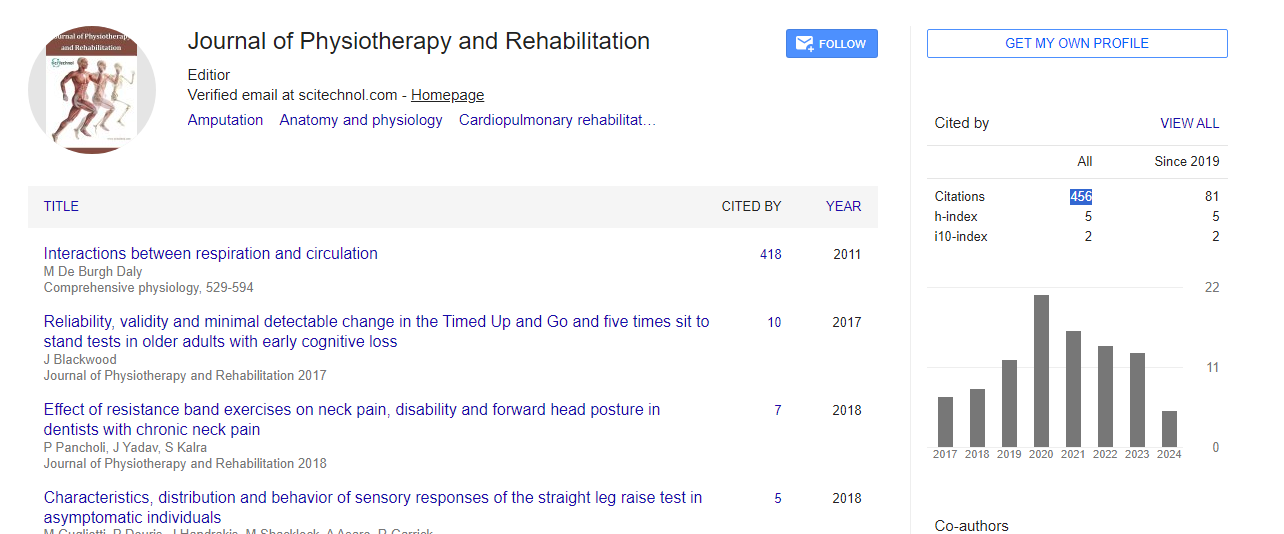Opinion Article, J Physiother Rehabi Vol: 8 Issue: 5
Innovative Physical Therapy Approaches for Restoring Mobility and Strength after Athletic Injuries
Amelia Hartman*
1Department of Rehabilitation, Ohio State University, Columbus, USA
*Corresponding Author: Sophia Morales,
Department of Rehabilitation, Ohio
State University, Columbus, USA
E-mail: amelia.hartman@rehab.edu
Received date: 24 September, 2024, Manuscript No. JPTR-24-151644
Editor assigned date: 26 September, 2024, PreQC No. JPTR-24-151644 (PQ);
Reviewed date: 10 October, 2024, QC No. JPTR-24-151644
Revised date: 17 October, 2024, Manuscript No. JPTR-24-151644 (R);
Published date: 24 October, 2024, DOI: 10.4172/JPTR.1000188.
Citation: Hartman A (2024) Innovative Physical Therapy Approaches for Restoring Mobility and Strength after Athletic Injuries. J Physiother Rehabi 8:5.
Description
Athletic injuries are a common occurrence, ranging from minor sprains to more severe muscle tears or fractures. For athletes, restoring mobility and strength quickly and effectively is critical to returning to peak performance. Over the years, physical therapy has evolved to incorporate innovative approaches that not only speed up recovery but also reduce the risk of re-injury. These advances focus on adjusting rehabilitation programs to the specific needs of each athlete, incorporating a variety of techniques and technologies that enhance the healing process and improve functional outcomes. One of the key innovations in physical therapy for athletic injuries is the use of functional movement assessments. Rather than focusing on the injured area, therapists now take a comprehensive approach by evaluating the athlete's overall movement patterns. This allows them to identify any biomechanical issues or compensatory movements that may have contributed to the injury or could hinder recovery. By addressing these underlying problems, physical therapists can develop more effective treatment plans that not only heal the injury but also improve the athlete's performance and prevent future injuries.
Strengthening exercises remain a foundation of rehabilitation, but modern therapy incorporates more dynamic and sport-specific training. Traditional static exercises are often combined with functional exercises that act the athlete's movements during their sport. For example, a soccer player recovering from a knee injury may perform exercises that simulate kicking, cutting and jumping, helping to restore both the strength and coordination required for these activities. This approach ensures that the athlete can regain the specific skills needed for their sport, rather than just general muscle strength. One such technology is the use of Blood Flow Restriction (BFR) training. This technique involves applying a specialized cuff to restrict blood flow to a limb during low-intensity strength exercises. By doing so, BFR stimulates muscle growth and strength without the need for heavy loads, making it ideal for athletes recovering from injuries who cannot yet handle traditional resistance training. Another technological advancement is the use of Neuromuscular Electrical Stimulation (NMES). This therapy involves the application of electrical currents to muscles, stimulating contractions that help to strengthen muscles, improve coordination and reduce atrophy during periods of immobilization. NMES is particularly useful for athletes who are unable to perform full exercises due to the severity of their injury. By activating muscles through electrical stimulation, athletes can maintain muscle tone and strength, which can significantly shorten the rehabilitation period once they are cleared for active exercise.
Conclusion
Innovative physical therapy approaches for athletic injuries are focused on enhancing mobility and strength through functional training, advanced technology and personalized care. By incorporating these modern methods, athletes can recover more quickly and effectively, minimizing the risk of re-injury and enabling a smoother return to peak performance. Manual therapy techniques, such as soft tissue mobilization, joint manipulation and myofascial release, also continue to evolve. These hands-on approaches are used to reduce pain, improve tissue flexibility and restore joint mobility. Therapists use these techniques to address restrictions in the muscles, tendons and ligaments, which can otherwise impair movement and delay recovery.
 Spanish
Spanish  Chinese
Chinese  Russian
Russian  German
German  French
French  Japanese
Japanese  Portuguese
Portuguese  Hindi
Hindi 